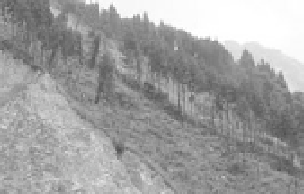Environmental Engineering Reference
In-Depth Information
Several rainstorms occurred after the experiment. Rain washed a part of the clay suspension down to
the lower part of the bare rock, which helped to spread the moss spores to a large area of the rock surface.
Figure 2.17(a) shows the grain erosion site at Xiaomuling on the Mianyuan River. Figure 2.17(b) shows
the clay suspension layer with moss spores. Two moss species had germinated on the rock surface after one
month of the experiment. Two months later the experimental plots had become green with a thin layer of
moss growing, as shown in Fig. 2.17(c). Because rainstorms spread the clay suspension to the lower part
of the rocks, the area of greened rock surface was larger than the rock surface with clay cover at the
beginning of the experiment. Only two species of moss:
Rhizomnium sp.
and
Grimmia sp
. successfully
germinated on the rock surface. Both of the species were collected from local vegetated rocks.
(a) (b) (c)
Fig. 2.17
(a) Grain erosion site at Xiaomuling on the Mianyuan River, Sichuan; (b) Clay suspension with moss spores
was splashed on the Xiaomuling grain erosion rock; (c) Two months later the rock surface was green and grain
erosion was controlled (See color figure at the end of this topic)
Selection of moss species is important for the success of the vegetation restoration. However, the clay
suspension with moss spores must be poured onto the top part of the local bare rock. If only a lower part
of the bare rock is covered with clay suspension and it is revegetated, while the grain erosion on the upper
part continues, the grains falling from upper part may destroy or bury the newly greened lower rock
surface. The grain erosion rock surfaces in the Minjiang River valley are rather high and very dangerous for
humans to climb up. Helicopters may be used to pour the clay suspension with moss spores onto the top
of the bare mountains in order to quickly control grain erosion and revegetate the bare mountains.
2.2
Vegetation
2.2.1
Various Vegetations
Generally, vegetation affects the fluvial process and the development of the drainage network, including
the channel incision process. In the past century human activities have resulted in deforestation in many
countries. Extensive loss of vegetation cover in the watershed can decrease infiltration and increase runoff,
leading to higher flood peaks and additional runoff volume. Where reduced cover increases overland
flow and reduces infiltration, additional water may flow more rapidly into stream channels, producing a
more “flashy” stream system. Reductions in base flow and increases in storm flow can result in a formerly










Search WWH ::

Custom Search